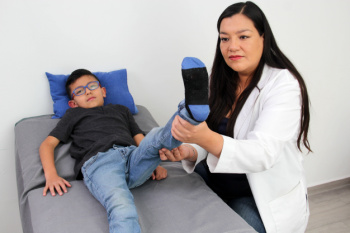Connect With Us
Blog
Items filtered by date: October 2024
Foot Pain While Cycling

Foot pain during cycling is a common issue that can arise from several factors, significantly impacting performance and comfort. One primary reason is wearing improper cycling shoes. Shoes that do not fit well can lead to pressure points and discomfort, making it essential to choose footwear that provides adequate support and a snug fit. Another critical factor is the location of the cleats. Misaligned cleats can cause improper foot positioning, resulting in pain and strain on the feet during pedaling. Ensuring that cleats are positioned correctly can promote a more natural pedal stroke and distribute pressure evenly across the foot. Additionally, consider adjusting the pedal tension and maintaining proper bike fit to enhance comfort. Having foot pain while cycling can cause temporary time off from pursuing this hobby. If this applies to you, it is suggested that you consult a podiatrist who can offer you effective relief and treatment solutions.
Ankle and foot injuries are common among athletes and in many sports. They can be caused by several problems and may be potentially serious. If you are feeling pain or think you were injured in a sporting event or when exercising, consult with one of our podiatrists from Complete Foot & Ankle Specialists, LLC. our doctors will assess your condition and provide you with quality foot and ankle treatment.
Common Injuries
The most common injuries that occur in sporting activities include:
- Achilles Tendonitis
- Achilles Tendon Rupture
- Ankle Sprains
- Broken Foot
- Plantar Fasciitis
- Stress Fractures
- Turf Toe
Symptoms
Symptoms vary depending upon the injury and in some cases, there may be no symptoms at all. However, in most cases, some form of symptom is experienced. Pain, aching, burning, bruising, tenderness, tightness or stiffness, sensation loss, difficulty moving, and swelling are the most common symptoms.
Treatment
Just as symptoms vary depending upon the injury, so do treatment options. A common treatment method is known as the RICE method. This method involves rest, applying ice, compression and elevating the afflicted foot or ankle. If the injury appears to be more serious, surgery might be required, such as arthroscopic or reconstructive surgery. Lastly, rehabilitation or therapy might be needed to gain full functionality in the afflicted area. Any discomfort experienced by an athlete must be evaluated by a licensed, reputable medical professional.
If you have any questions, please feel free to contact our offices located in Bellefontaine, OH and Springfield, OH . We offer the newest diagnostic and treatment technologies for all your foot care needs.
Flat Feet and Overpronation in Children

Flat feet and overpronation are common concerns among children, often leading to discomfort and potential issues in mobility. Flat feet occur when the arches of the feet do not develop properly, resulting in the entire foot making contact with the ground. This condition can lead to overpronation, where the feet roll inward excessively during walking or running. Parents may notice signs such as fatigue, difficulty in participating in physical activities, or complaints of foot pain. Early detection is essential, as untreated flat feet can contribute to alignment issues and discomfort in the knees, hips, and back. Simple interventions like supportive footwear and specific exercises can make a significant difference in a child's comfort and overall foot health. If your child has any of the above symptoms, it is suggested that you contact a podiatrist who can offer effective relief and treatment options.
Making sure that your children maintain good foot health is very important as they grow. If you have any questions, contact one of our podiatrists of Complete Foot & Ankle Specialists, LLC. our doctors can provide the care you need to keep you pain-free and on your feet.
Keeping Children's Feet Healthy
Having healthy feet during childhood can help prevent medical problems later in life, namely in the back and legs. As children grow, their feet require different types of care. Here are some things to consider...
Although babies do not walk yet, it is still very important to take care of their feet.
Avoid putting tight shoes or socks on his or her feet.
Allow the baby to stretch and kick his or her feet to feel comfortable.
As a toddler, kids are now on the move and begin to develop differently. At this age, toddlers are getting a feel for walking, so don’t be alarmed if your toddler is unsteady or ‘walks funny’.
As your child gets older, it is important to teach them how to take care of their feet.
Show them proper hygiene to prevent infections such as fungus.
Be watchful for any pain or injury.
Have all injuries checked by a doctor as soon as possible.
Comfortable, protective shoes should always be worn, especially at play.
If you have any questions please feel free to contact our offices located in Bellefontaine, OH and Springfield, OH . We offer the newest diagnostic and treatment technologies for all your foot and ankle needs.
Ankle Fracture? Don’t Wait for Treatment
A Guide to Finding Your Perfect Fit in Running Shoes

Running shoes are specifically designed footwear that provides support, cushioning, and protection for runners during their activities. When selecting the best pair of running shoes, consider essential features like cushioning, shock absorption, and energy return, as these elements enhance comfort and performance. Runners can choose from various types of shoes to suit their needs. Lightweight shoes are ideal for speed, while road shoes offer a smoother ride on pavement. Motion control shoes provide added stability for those with overpronation, and trail shoes are designed for off-road conditions, featuring rugged outsoles for better grip. Training shoes are versatile for various activities, whereas zero-drop shoes promote a more natural running posture with no height difference between the heel and toe. Many runners develop foot conditions as a result of wearing shoes that are not right for their style or running. If this applies to you, it is suggested that you consult a podiatrist who can offer you relief solutions and guide you on how to choose running shoes that are right for you.
You should always make sure your running shoes fit properly in order to avoid injury. For more information, contact one of our podiatrists from Complete Foot & Ankle Specialists, LLC. our doctors can provide the care you need to keep you pain-free and on your feet.
Choosing the Right Running Shoe for Your Foot Type
Improper shoe sizing can cause a myriad of problems for your feet. Shoes that don’t fit you properly can lead to muscular imbalances in your body, which can result in foot, knee, and hip injuries.
Tips for Finding the Right Running Shoe
- Make sure you have a thumb’s width of wiggle room between the end of your longest toe and the front of the shoe.
- There should be little to no slipping at the heel
- Don’t assume your size in one shoe brand will be your size in another
- Do not lace up your shoes too tightly
- Walk around in the store with your new shoes before you buy them
If you have any questions please feel free to contact our our offices located in Bellefontaine, OH and Springfield, OH . We offer the newest diagnostic and treatment technologies for all your foot and ankle needs.
Understanding Plantar Fasciitis

Plantar fasciitis is an inflammation of the plantar fascia, the thick band of tissue that runs along the bottom of the foot. This condition often leads to significant discomfort, particularly in the heel and arch, and is commonly associated with symptoms such as swelling and stiffness. Many individuals report sharp pain upon taking their first steps in the morning or after prolonged periods of rest. Several factors contribute to the development of plantar fasciitis, including excessive physical activity, improper footwear, and obesity. Additionally, individuals with flat feet or high arches may be at greater risk. Plantar fasciitis can cause severe pain and discomfort. If you are experiencing heel pain, it is strongly suggested that you contact a podiatrist who can accurately diagnose and treat plantar fasciitis.
Plantar fasciitis can be very painful and inconvenient. If you are experiencing heel pain or symptoms of plantar fasciitis, contact one of our podiatrists from Complete Foot & Ankle Specialists, LLC. our doctors can provide the care you need to keep you pain-free and on your feet.
What Is Plantar Fasciitis?
Plantar fasciitis is the inflammation of the thick band of tissue that runs along the bottom of your foot, known as the plantar fascia, and causes mild to severe heel pain.
What Causes Plantar Fasciitis?
- Excessive running
- Non-supportive shoes
- Overpronation
- Repeated stretching and tearing of the plantar fascia
How Can It Be Treated?
- Conservative measures – anti-inflammatories, ice packs, stretching exercises, physical therapy, orthotic devices
- Shockwave therapy – sound waves are sent to the affected area to facilitate healing and are usually used for chronic cases of plantar fasciitis
- Surgery – usually only used as a last resort when all else fails. The plantar fascia can be surgically detached from the heel
While very treatable, plantar fasciitis is definitely not something that should be ignored. Especially in severe cases, speaking to your doctor right away is highly recommended to avoid complications and severe heel pain. Your podiatrist can work with you to provide the appropriate treatment options tailored to your condition.
If you have any questions please feel free to contact our offices located in Bellefontaine, OH and Springfield, OH . We offer the newest diagnostic and treatment technologies for all your foot and ankle needs.

